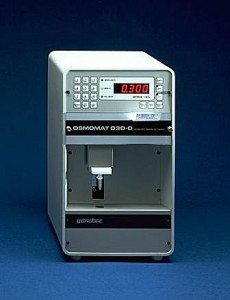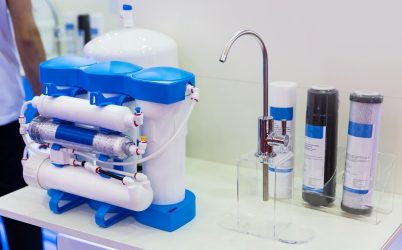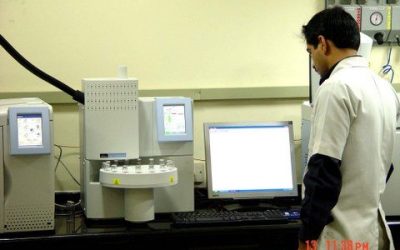
Osmolality measurements using an osmolality meter or an osmometer are regularly carried out in the pharmaceutical industry and research labs.
It is done to establish the isotonicity of intravenous solutions, injection, nasal, and eye drops. We will first go through the importance of osmolality and osmolarity calculation. So you will be able to understand why everyone in the pharmaceutical industry wants to keep the measurements accurate.
Understanding Osmometry
Osmosis is defined as the passage of solvent into a solution through a semi-permeable membrane. This process eventually leads to equilibrium and the tendency of the solvent to move from one side of the membrane to the other can be measured by the closely related colligative property called osmotic pressure.
Osmotic pressure is classically given in terms of atmospheres, but in clinical practice, it is expressed in terms of osmoles (Osm) or milliosmols (mOsm). 1-osmolal solution is defined as the solution containing one mole of a non-ionising substance in 1 kg of water.
It is a measure of the total number of particles dissolve in a kilogram of water and depends on the electrolytic nature of the solute, an ionic solute will dissociate in water to form ions or particles. The apparent number of particles in solution is measured using an osmometer.
Osmolarity is used more frequently than osmolality in the labeling of parenteral solutions in, pharmaceutical manufacturing, hospitals, and pharmacies. But osmolarity cannot be measured and must be calculated experimentally by data mining the osmolality of a solution.
For near ideal solutions, osmolarity different from osmolality only by 1 or 2 %, but as you go towards more concentrated solutions of polyvalent electrolyte together with buffers, preservatives, and other ions these differences become larger.
For accuracy in the preparation and labeling of parenteral solutions, osmolality should be measured carefully with the vapor pressure or freezing point based osmometer rather than being calculated based on the concentrations of ingredients added.
Importance of Osmolality and Osmolarity Measurement
By now, you must have understood that both osmolality and osmolarity are the calculation of the osmotic pressure generated by different solutions. It is considered as one of the most crucial traits of infusion solutions.
That is why every infusion solution must specify its theoretical osmolarity value on its label. Hence, the experts are able to determine whether the compound is suitable for their purpose or not.
For example, preparations that are hypertonic or hypotonic in nature can cause severe irritation when injected into the bloodstream or tissue or when applied to mucous membranes like cornea and wounds. So industry specialists will not recommend the same.
Normal ranges of osmolality
The osmolality of blood, measured using osmometer, ranges from 250 to 350 mOsm/kg and the normal osmolarity of body fluids given in medical books ranges from 275 to 295 mOsm/kg, but normal values usually fall in an even narrower range of 286±4 mOsm/kg. Parenteral preparations are developed to closely match the values to reduce the irritation caused by them.
Osmometer Instrument Applications
Osmometers’ first use was seen in the late nineteenth century. At that time, it was used for measuring dilute preparations’ osmotic strength by varying its concentration levels.
Guerrero et al. also conducted an analytical study for validating the use of osmometers. Under the study, they tested urine osmolality of over 1900 dogs. Due to its raised effectiveness and reliability, this approach was further passed on for several other purposes.
While the use of an osmometer instrument is seen in various domains, its primary application stays in the clinical studies and treatments. Industry experts utilize these for measuring biological samples’ solute concentrations. For example, the instrument can determine the strength of solutes in components like blood plasma and human tears.
The data received from these osmolarity measurements can further be used for the early detection of a range of medical issues. This not only ensures proper treatment but also reduces the overall healthcare costs related to it.
Apart from this, osmometry is utilized in the testing of consumer products. The process can quickly provide the data to assure the products’ quality as the given standards. For example, freezing point osmometers provide veracity of isotonic beverages, such as sports drinks and non-alcoholic beers, through their proper screening.
So we can say that osmolality measurement using an osmometer is a pharmacopeia requirement for numerous products.
Further, the United States Pharmacopoeia (USP) gives the option of using either a vapor pressure based osmometer or a cryoscopic (depression increasing point-based) osmometer for the measurement of osmolarity. Whereas the Indian Pharmacopoeia (IP) only describes the cryoscopic osmometer for the measurement of osmolarity.
The Cryoscopic Freezing Point Osmometer
The freezing point osmometer is a widely used variety of osmometer instrument that is based on the concept of depression in freezing point due to osmotically active aspects. In other words, it helps in finding the solution’s strength with the help of its freezing point depression.
Two more techniques involved here are:
- Membrane Osmometry: This is used for determining the solutions’ osmotic pressure.
- Vapor Pressure Osmometry: Several particles of the solution cause a drop in the compound’s vapor pressure, melting point, and freezing point. This osmometry is used for finding these particles’ concentration.
The entire process consists of four different steps: calibration, loading, deep freezing, and measurement. It is a fast and convenient way to measure the osmolality of aqueous solutions. Plus, its precision in results promotes its use in the medical sector.
The current technologies allow automatic determination of osmolality with the help of different in-built components, such as the Peltier cooler and microprocessors.
Features of the Osmometer Installed at Arbro
Now that you have understood everything about osmolarity and osmolality, let’s move on to the details of Arbro’s osmometer’s details.
Arbro has recently installed an osmometer based on freezing point depression in our state of the art testing lab in New Delhi. The system has numerous advantages such as –
- Automated calibration
- A short measurement time of 1 min
- Automated measurement and calculation
- The low sample volume of only 50 µl
- Built-in printer and
- Three-point calibration
- Reproducibility of less than ±0.5% for 50 µm samples
- A large measuring range of up to 3000 mOsm/kg
- A resolution of 1 mOsm/kg over the entire measuring range
The system has been installed and duly qualified as per our internal quality systems which are accredited by NABL to ISO/IEC 17025 and is now ready for service for our customers in various industries.
Contact us today!
If you require the measurement of osmolality of any of your products, contact us today using the Quick Query Form on the right or call us now on +91-11-45754575. We will be happy to help you out!
If there is any further information required on this topic, feel free to leave a comment below.

















2 Responses
we require for patients serum,urine analysis